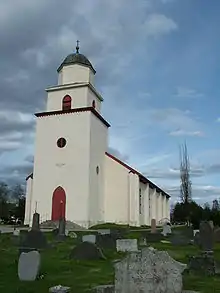Grue Church
Grue Church (Norwegian: Grue kirke) is a long church (Norwegian: langkirke) dating from 1825 in Grue in Innlandet county, Norway.
| Grue Church | |
|---|---|
Grue kirke | |
 | |
 Grue Church Location in Innlandet  Grue Church Grue Church (Norway) | |
| Location | Grue |
| Country | Norway |
| Denomination | Church of Norway |
| Churchmanship | Evangelical Lutheran |
| History | |
| Status | Parish church |
| Architecture | |
| Functional status | Active |
| Architect(s) | Hans Linstow |
| Completed | 1825 |
| Specifications | |
| Capacity | 500[1] |
| Materials | Stone |
| Administration | |
| Deanery | Solør |
Structure and history
The church is built of stone and can accommodate 500 people.[1] It has massive dimensions; it measures 47 by 18 meters (154 ft × 59 ft)[2] and the walls are 1.26 meters (4.1 ft) thick. The church has a very simple outer form, composed of a tower and a nave with basic geometric shapes. The plans for the church were largely the work of the architect Hans Linstow,[1][3] assisted by Ole Peter Riis Høegh,[4] and it was the first Gothic Revival structure in Norway. The cornerstone for the new church was laid in September 1827. The church was consecrated on September 28, 1828[2] by Bishop Christian Sørenssen. Many families from the Grue Church in Norway, left for the United States, and in the 1870s formed at least two new congregations - both of which were named to honor their home church back in Norway. Grue Norwegian Evangelical Lutheran Church was built in rural Buxton, Traill County, North Dakota, and another Grue Lutheran Church was built in rural Ashby, Ottertail County, Minnesota.
The old church
The old Grue Church stood further to the north of the Grue rectory. It was threatened by erosion from the Glomma River, which carried away large amounts of soil near the church every year. On May 17, 1794 permission was given for the church to be relocated to the municipal subdivision of Vollermoen and for it to be built in stone. However, this permit was never used. The church was first relocated after the Grue Church fire on Pentecost, May 26, 1822, in which at least 113 people died.[5] The old church was a cruciform stave church partially constructed with dovetail joints. During the Catholic era, the church was dedicated to John the Baptist.
See also
References
- Kirkesøk: Grue Church.
- Norske kirkebygg: Grue kirke.
- Norsk biografisk leksikon: Hans Ditlev Frantz Linstow.
- Norsk biografisk leksikon: Peter Høegh.
- Nesse, Oskar. 1968. Kyrkjene på Borgund, nyekyrkja 100 år. Borgund: Nyekyrkja, p. 16.